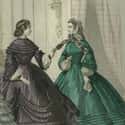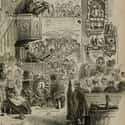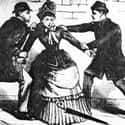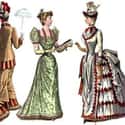Random Women's Dresses Used To Be Flammable Death Traps, Killing 3,000 Ladies In One Year (11 items)
-
(#6) Even Archduchesses Weren't Safe From Death By Dress
There were no social divides when it came to dying by burning garments. In 1861, Henry Wadsworth Longfellow's wife, Fanny, died when her dress caught on fire; she perished in front of her own children. In 1871, Mary and Emily Wilde, the half-sisters of Oscar Wilde, met a similar fate at a Halloween party. One of the women was dancing when her dress caught fire, and her sister rushed to help her. However, the fire just spread, and both women burned to death.
An influential woman in her own right, Archduchess Mathilde of Austria, also met a fiery end. She was smoking a cigarette when her father, who had forbidden them in his presence, approached her to talk. She hid the cigarette behind her back, which then set her dress aflame. The gown was gauze, and very flammable, and her whole body went up in an instant. She died at only 18.
-
(#4) Women Actually Wore Arsenic
The danger of a Victorian dress was compounded by the fact that it was often dyed with dangerous chemicals, most especially arsenic. Green was a particularly fashionable color in the Victorian era, and a good way to get that shade was with arsenic dye. Hats, gloves, and yes, even dresses, were colored green with the chemical; without even catching on fire, some women died horrible deaths as a result.
In 1861, a 19-year-old artificial flower maker named Matilda Scheurer was felled by the simple act of working with the dye. She convulsed and vomited, then foamed at the mouth in a harsh shade of green. It was later discovered that there was arsenic in her liver, lungs, and stomach. The level was so high that even the whites of her eyes were tinged green.
While arsenic-laced dresses were dangerous enough, the flammability factor only made things worse. Burning an arsenic dress could release toxic fumes into the air which, of course, the woman wearing the dress would inhale. Even if she wasn't killed immediately by the flames, just breathing the smoke could cause serious health problems and lead to her early demise.
-
(#10) These Ornate Dresses Used To Be Called Sinful
Believe it or not, many people did object to flowing dresses during the Victorian era, but not because of how flammable they were. Instead, they were regarded as preposterous, and even evil. To be fair, crinoline dresses were sometimes used for nefarious purposes. French toll bridges regularly seized alcohol, tobacco, gunpowder, partridges, and even concealed people that women hid within their dresses. During the Civil War, women smuggled goods to troops in their massive skirts. Cartoonists of the day depicted men as being unable to hold hands with their wives because their skirts were too big.
What's more, some preachers suggested that these skirts were sinful. Ministers began to tell their congregations that crinoline skirts were basically going against Christianity, and were a social evil.
It was this belief, as well as the dresses' impracticality, that eventually caused them to become passé, saving countless lives in the process.
-
(#1) Despite Thousands Of Fatalities, Women's Fashion Didn't Change
Although death by flaming dress might seem like only an occasional hazard, Victorian garments catching on fire actually killed thousands of women a year. Through the early-to-mid 1800s, women continued to wear incredibly flammable clothing despite widespread reports of death and injury; apparently they just considered it the price of fashion.
Even when the British medical journal The Lancet decided to publish their findings regarding the surge in deaths, it did little at the time to deter prevailing trends. The Lancet estimated in 1860 that at least 3,000 woman were killed in a single year by fire.
-
(#11) Changing Fashion Trends Actually Made Clothing Safer
You might think that, with all these deaths, changes would be made to clothing in order to protect women. A few places of work did step up to ban the dangerous dresses, including a textile company that reportedly restricted crinoline usage in 1898 after the death of a worker at a firewood factory. But such rules had less impact than the tide of fashion – it simply changed, and different shapes came into vogue.
Arsenic dyes were eventually phased out; flammable fabric was still generally used, but at least the shapes of dresses began to change. In the 1870s, bustles became the new fad, meaning the bulk of the dress was in the back while the front remained relatively slim. This drastically reduced the possibility of a skirt becoming a flaming cone of fire. By the 1890s, skirts had become even slimmer, meaning that women could move around their homes without being at such a constant high risk of catching flame.
Fashion aside, the large-scale implementation of electricity helped reduce prevalence of open flames within the home, further cutting down on deadly incidents.
-
(#9) The French Made Fire-Resistant Clothing, But It Was Slow To Catch On
The amount of fire-related deaths couldn't go unchecked forever, and the French were among the first to take steps to fight against the scourge. In 1859, there was a decree that all theater workers must wear flame-resistant clothing. Joseph Louis Gay-Lussac actually started creating flame-resistant fabric in 1821, using ammonium phosphates, borax, and boric acid. The process made the clothing yellow and stiff, and it could wash out if you weren't careful, but it was a start.
However, many ballerinas refused to wear the stiff fabric. They believed it took away from a woman's beauty and her delicate poise on stage, which could hurt a dancer's image. Most dancers of the day lived off money from patrons, and as such they felt pressured to appear as pretty and delicate as possible. For some, it simply wasn't an option, and they paid the price with their lives.
New Random Displays Display All By Ranking
About This Tool
Boning corsets and crinoline petticoats were very popular in the Victorian era, but these dresses were tight enough to make people faint. These oversized petticoats had very exaggerated perimeters and wide flouncing. They were so large that they could even protect women from drowning. Although hoop petticoats were a symbol of fashion at that time, they were very dangerous. , Because this material is very flammable.
During the 1850s, the fluffy and wide skirts were made of multiple layers of skirts, once it is accidentally ignited, the flame will spread quickly in the fabric. More than 3,000 people died from the skirts. The random tool introduced 11 details about these beautiful but dangerous women's dresses.
Our data comes from Ranker, If you want to participate in the ranking of items displayed on this page, please click here.






